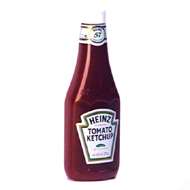There is certainly some overlap between molecular gastronomy, kitchen chemistry, gastro physics, culinary physics and everyday chemistry… That’s why I thought the January 2004 issue of Physics Education would be of interest. It features a section on food physics, covering topics such as melting of chocolate, popping of popcorn, photographing food with visible and infrared light etc. Most of the material is for subscribers only (your local university library probably has a subscription!), but the free material includes a nice article by Jon Ogborn (entitled “Soft matter: food for thought”) on foams, gels and emulsions. Did you for instance know that mayonnaise is thixotropic?
This means that it only flows after a certain minimum stress has been applied (figure 6). This is unusual. Liquids usually flow even under the smallest stress.
Non-drip paint is also thixotropic. It retains its shape, but becomes fluid when enough stress is applied, for example when a paint-roller moves through it. Once the stress is removed, the paint becomes stiff again, as it is then only affected by gravity, and does not flowdown the coated surface. It contains large molecules that form a gel, keeping the paint in place. The gel structure breaks down if enough stress is applied, only to re-form quickly once the stress has been removed. So, paint is liquid on the brush and solid on the wall. Try painting with mayonnaise!
Thixotropic materials are also referred to as shear thinningpedia. However, according to this page, the terms thixotropic and shear thinning are easily confused, so here’s the IUPAC definitions:
Shear thinning: If viscosity is a univalued function of the rate of shear, a decrease of the viscosity with increasing rate of shear is called shear thinning, and an increase of the viscosity shear thickening.
The application of a finite shear to a system after a long rest may result in a decrease of the viscosity or the consistency. If the decrease persists when the shear is discontinued, this behaviour is called work softening (or shear breakdown), whereas if the original viscosity or consistency is recovered this behaviour is called thixotropy.
Ketchup is shear thinning (or was it thixotropic?), and an amusing website has even been set up to investigate “The great Ketchup mystery”.

Their conclusion so far is:
… the next time you whack the bottom of a ketchup bottle [consider this:] Even supercomputers can’t predict the outcome.
